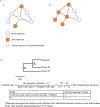Identifying Clusters of Recent and Rapid HIV Transmission Through Analysis of Molecular Surveillance Data
- PMID: 30222659
- PMCID: PMC6231979
- DOI: 10.1097/QAI.0000000000001856
Identifying Clusters of Recent and Rapid HIV Transmission Through Analysis of Molecular Surveillance Data
Abstract
Background: Detecting recent and rapid spread of HIV can help prioritize prevention and early treatment for those at highest risk of transmission. HIV genetic sequence data can identify transmission clusters, but previous approaches have not distinguished clusters of recent, rapid transmission. We assessed an analytic approach to identify such clusters in the United States.
Methods: We analyzed 156,553 partial HIV-1 polymerase sequences reported to the National HIV Surveillance System and inferred transmission clusters using 2 genetic distance thresholds (0.5% and 1.5%) and 2 periods for diagnoses (all years and 2013-2015, ie, recent diagnoses). For rapidly growing clusters (with ≥5 diagnoses during 2015), molecular clock phylogenetic analysis estimated the time to most recent common ancestor for all divergence events within the cluster. Cluster transmission rates were estimated using these phylogenies.
Results: A distance threshold of 1.5% identified 103 rapidly growing clusters using all diagnoses and 73 using recent diagnoses; at 0.5%, 15 clusters were identified using all diagnoses and 13 using recent diagnoses. Molecular clock analysis estimated that the 13 clusters identified at 0.5% using recent diagnoses had been diversifying for a median of 4.7 years, compared with 6.5-13.2 years using other approaches. The 13 clusters at 0.5% had a transmission rate of 33/100 person-years, compared with previous national estimates of 4/100 person-years.
Conclusions: Our approach identified clusters with transmission rates 8 times those of previous national estimates. This method can identify groups involved in rapid transmission and help programs effectively direct and prioritize limited public health resources.
Conflict of interest statement
Figures


References
-
- Centers for Disease Control and Prevention. HIV Surveillance Report, 2016. 2017.
-
- Smith DK, Van Handel M, Wolitski RJ, et al. Vital Signs: Estimated Percentages and Numbers of Adults with Indications for Preexposure Prophylaxis to Prevent HIV Acquisition--United States, 2015. MMWR Morb Mortal Wkly Rep. 2015;64(46):1291–1295. - PubMed
-
- Centers for Disease Control and Prevention. Estimated HIV Incidence and Prevalence in the United States, 2010–2015. HIV Surveillance Supplemental Report. 2018;23(1).
Publication types
MeSH terms
Substances
Grants and funding
LinkOut - more resources
Full Text Sources
Other Literature Sources
Medical

